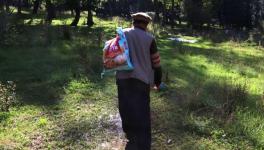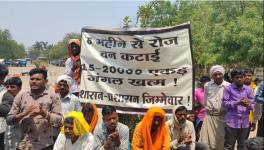How to Make India's Biggest Land Reform Fail

Image Courtesy: livemint
Forests in India are a contested territory. The three major interest groups here are the forest dwellers, the business and industrial interests, and the conservationists. The conservationists themselves are a varied lot. There are those who are either diehard conservationists or backed by the corporate lobby, and there are those who are sensitive to the forest dwelling communities' interests. The present proposed National Forest Policy 2018 will certainly skew the balance in favour of only one of the groups. As has been pointed out, the policy will enable the Union Government to frame new Rules, which will serve to dilute The Scheduled Tribes and Other Traditional Forest Dwellers (Recognition of Forest Rights) Act, 2006, commonly referred to as the Forest Rights Act (FRA). However, the specificities of the policy, which will skew the scales need to be considered.
The objectionable parts concern the government's strategy for attaining the aims of the policy. Under the heading 'Management of trees outside forests', the government proposes promoting agro-forestry and farm forestry. To achieve this at point (iv), the document has mentioned “[s]uitable location specific Public Private Partnership models will be developed involving Forest Departments, Forest development Corporations, Communities, Public limited companies etc. for achieving the target of increased forest & tree cover in the country.” The fear here is that in carrying out agro-forestry and other allied activities, the FRA can be diluted to facilitate the objective of 'increasing tree cover'.
In the same chapter, under the heading of 'New thrust areas in forest & tree cover management', the document proposes 'production forestry'. This entails encouraging the states to “further develop their plantation programmes with scientific inputs and genetically improved planting materials”. The stated idea behind this is that the demand for timber has been growing over the years, and that dependence on imports should be reduced. However, at a later part in the chapter, the document mentions facilitating a forest-industry interface. Under this, farmer producers would be encouraged to grow timber and other produce – presumably bamboo, since the pulp is used in paper production – for industries. This portion of the document may appear to be socially driven, since it could create jobs. However, the conflict with the FRA still persists.
Before getting to the FRA, the other significant forest laws require attention. One of the first legislations dealing with forests was the Indian Forest Act, 1927. This Act creates four types of forest land: reserved forest, village-forest, protected forest, and forest land not being the property of the government. Under the Act, all four categories of land are notified by the state government.
In the case of reserved forest, if anybody was living on the land notified before the notification was published, that person would have to appeal to the Forest Settlement Officer (FSO). The FSO would then assess the person's claim over the land and decide whether to permit their habitation or not. If the person is allowed to continue to reside, then the person will be barred from using anything from the forest and can only cultivate that part which was already being cultivated upon. If the person claiming rights practices shifting cultivation (jhum) then the FSO would take into consideration any regulations regarding jhum before submitting his statement to the state government. The state government too has the authority to de-notify a reserved forest. In the case of village-forests, the provisions are the same, except rather than vesting rights in an individual, the rights are vested in a village.
Protected forests however are different to the extent that before a notification is issued, the state government is expected to conduct a survey of the area and its inhabitants, before notifying an area as protected forest. Only after taking due consideration that the rights of the persons residing in such area will not be impinged, the area can be notified as protected forest. However, the proviso states that if the government feels that the survey would take an inordinately long time to be completed, it may be overlooked. When it comes to forest land not being the property of the government, the government can still regulate what activities are prohibited; these include: clearing the land for cultivation, pasturing, and burning the vegetation.
While prima facie it appears that there are ample opportunities for communities and individuals to submit claims regarding their rights over land use, the issue arises over access to information. Many communities living in forested areas suffer from lack of information concerning government policies, let alone notifications in the official gazette. Therefore, even if they were literate at the time the law was passed, access to this information would have been extremely difficult. Furthermore, due to the proviso concerning protected forests, the government is capable of circumventing the rights of those living in the notified areas.
In 1980, rather than worrying about the status of those whose ancestral land had – by virtue of a notification – fallen under any of the four types of forest, the government passed The Forest (Conservation) Act, 1980. This Act took away the power of the state government to de-notify forest land, in the name of conserving forests. It would take 26 years for the FRA to be enacted.
The Scheduled Tribes and Other Traditional Forest Dwellers (Recognition of Forest Rights) Act, 2006 officially recognised the rights of forest dwellers for the first time. However, at the time it was passed, it faced stiff opposition from two interest groups – the industrial lobby and the environmentalists. The former argued that the Act would add to the already long list of legislation that hampers economic development. Whereas, the latter argued that the forest dwellers would destroy the forests by felling trees for agriculture. In 2017, Broome, Rai, and Tatpati argued in their article published in Economic and Political Weekly: ‘Biodiversity Conservation and Forest Rights Act’, that recognising community rights over forests actually ensures their conservation. Another article in the same issue by Kumar, Singh and Rao titled ‘Promise and Performance of the Forest Rights Act: A Ten-year Review’ reviewed the Act's implementation. What they found was that “[b]arely 3% of the estimated potential for [Community Forest Resources] rights recognition, that is, 2.7 million acres out of 35.6 million acres, has been achieved. The recognition of [Individual Forest Rights] has fared better in comparison with an estimated recognition of 3.84 million acres, though evidence shows that even that process has suffered from serious shortcomings.”
The key takeaway here is that despite the FRA being decried by the environmentalists and the industrial lobby, barely any land has actually accrued to the forest dwellers. Further, where land has accrued to a community rather than to individuals, it has not adversely affected conservation efforts. Thus, it should be clear that any argument for 'increasing tree cover' can pave the way for diluting the rights conferred under the Act, without having any rational basis for doing so. The problem here arises over the policy document and the Forest (Conservation) Act. The Act makes the de-recognition of forests dependent upon approval from the Union Government – the same institution that drafted the policy document. Considering the partisan nature of the current polity of the country, a direction from a party head can have a clear bearing on the activities undertaken by a state government. Thus, if this policy were to be passed, one would have to see which states are the first to start de-recognising forest land.
Get the latest reports & analysis with people's perspective on Protests, movements & deep analytical videos, discussions of the current affairs in your Telegram app. Subscribe to NewsClick's Telegram channel & get Real-Time updates on stories, as they get published on our website.
























